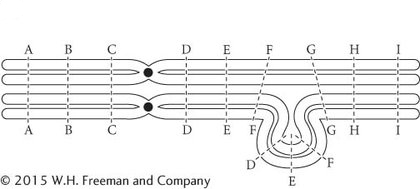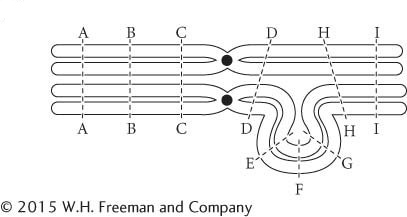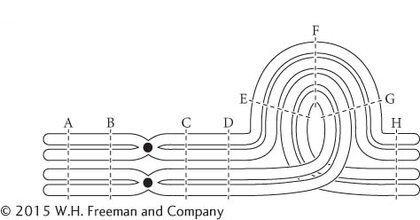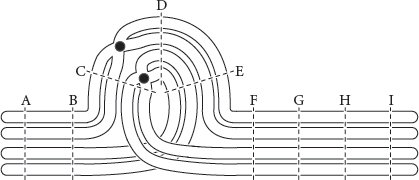Chapter 6
(a) Duplications; (b) polyploidy; (c) deletions; (d) inversions; (e) translocations.
Tandem duplication of AB
Displaced duplication of AB
Paracentric inversion of DEF
Deletion of B
Deletion of FG
Paracentric inversion of CDE
Pericentric inversion of ABC
Duplication and inversion of DEF
Duplication of CDEF, inversion of EF
Each crossover event results in two recombinant and two nonrecombinant gametes. If one crossover occurs in 100% of meioses, the result would be 50% recombinant gametes. If crossing over occurs within the pericentric inversion at a rate of 26% of meioses, then 13% of the woman’s oocytes will have a duplication-
containing or deficient chromosome 8. If all these oocytes form viable eggs, and if they do not result in early miscarriage after fertilization, then the probability of the couple having a child with a syndrome caused by the crossing over is 13%.
Because the father has normal color vision, the mother must be the carrier for color blindness. The color-
blind young man with Klinefelter syndrome must have inherited two copies of the X chromosome with the color- blindness allele from his mother. The nondisjunction event took place during meiosis II of the egg. The high incidence of Down syndrome in Bill’s family and among Bill’s relatives is consistent with familial Down syndrome, caused by a Robertsonian translocation of chromosome 21. Bill and his sister, who are unaffected, are phenotypically normal carriers of the translocation and have 45 chromosomes. Their children and Bill’s brother, who have Down syndrome, have 46 chromosomes. From the information given, there is no reason to suspect that Bill’s wife Betty has any chromosome abnormalities. Therefore, statement d is most likely correct.
In mammals, the higher frequency of sex-
chromosome aneuploidy than of autosomal aneuploidy is due to X- chromosome inactivation and the lack of essential genes on the Y chromosome. If fishes do not have X- chromosome inactivation, and if both of their sex chromosomes have numerous essential genes, then the frequency of aneuploids should be similar for both sex chromosomes and autosomes.
Such allotriploids could have 1n from species I and 2n from species II for 3n = 18; alternatively, they could have 2n from species I and 1n from species II for 3n = 15.
4n = 28
2n + 1 = 9
2n – 1 = 13
2n + 2 = 10
Allotetraploids must have chromosomes from both species, and total 4n. There are three possible combinations for such allotetraploids: 2n from each: 2(4) + 2(7) = 22; 1n from species I + 3n from species II: 1(4) + 3(7) = 25; 3n from species I + 1n from species II: 3(4) + 1(7) = 19.



